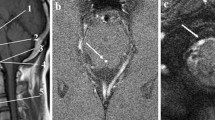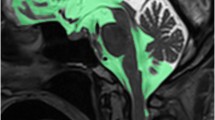Abstract
To determine the difference in the velocity parameters of cerebrospinal fluid flow in patients with varying severity of communicating hydrocephalus compared to a group of healthy volunteers without hydrodynamic disorders. The study involved 35 subjects with communicating hydrocephalus (25 subjects with Evans index of 0.31; 10 subject with Evans index of 0.46) and 62 healthy volunteers. The mean, volume, and peak flow velocities were determined at the different intracranial levels. Also were made an assessment of gender and age differences. Analysis of the differences between the mean values showed the progressive inhibition of cerebrospinal fluid outflow from the cranial cavity [in moderate communicating hydrocephalus—at 1.5 times (p < 0.05), in severe communicating hydrocephalus at 2–2.5 times (p < 0.01)], depending on the severity of enlargement of the ventricular system and, most likely, related to inhibition of its reabsorption. These changes may explain the clinical symptoms of subjects and serve as diagnostic criteria. Also it was revealed a significant influence of the factor of age on speed characteristics of the cerebrospinal fluid flow (F = 5.3303, p = 0.0003, for mean velocity).





Similar content being viewed by others
References
Teo C, Johnston I (2000) Disorders of CSF hydrodynamics. Child’s Nerv Syst 16:776–799. doi:10.1007/s003810000383
Greitz D (2004) Radiological assessment of hydrocephalus: new theories and implications for therapy. Neurosurg Rev 27(3):145–165. doi:10.1007/s10143-004-0326-9
Johnston I, Howman-Giles R, Whittle I (1984) The arrest of treated hydrocephalus in children. J Neurosurg 61:752–756
Larsson A, Jensen C, Bilting M, Ekholm S, Stephensen H, Wikkelso C (1992) Does the shunt opening pressure influence the effect of shunt surgery in normal pressure hydrocephalus? Acta Neurochir 117:15–22. doi:10.1007/BF01400629
Bhadelia RA, Bogdan AR, Wolpert SM (1995) Analysis of cerebrospinal fluid flow waveforms with gated phase-contrast MR velocity measurements Am. J Neuroradiol 16:389–400
Baledent O, Henry-Feugeas MC, Idy-Peretti I (2001) Cerebrospinal fluid dynamics and relation with blood flow: a magnetic resonance study with semiautomated cerebrospinal fluid segmentation. Invest Radiol 36(7):368–377. doi:10.1097/00004424-200107000-00003
Matsumae M, Kikinis R, Morocz I, Lorenzo A, Albert M, Black P, Lolesz F (1996) Intracranial compartment volumes in patients with enlarged ventricles assessed by magnetic resonance-based image processing. J Neurosurg 84(6):972–981
Toma AK, Holl E, Kitchen ND, Watkins LD (2011) Evans’ index revisited: the need for an alternative in normal pressure hydrocephalus. Neurosurgery 68(4):939–944. doi:10.1227/NEU.0b013e318208f5e0
Huang TY, Chung HW, Chen MY, Giiang LH, Chin SC, Lee CS, Chen CY, Liu YJ (2004) Supratentorial cerebrospinal fluid production rate in healthy adults: quantification with two-dimensional cine phase-contrast MR Imaging with high temporal and spatial resolution. Radiology 233:603–608. doi:10.1148/radiol.2332030884
Nitz WR, Bradley WJ, Watanabe AS, Lee RR, Burgoyne B, O’Sullivan RM, Herbst MD (1992) Flow dynamics of cerebrospinal fluid: assessment with phase-contrast velocity MR imaging performed with retrospective cardiac gating. Radiology 183:395–405
Levine DN (2008) Intracranial pressure and ventricular expansion in hydrocephalus: have we been asking the wrong question? J Neurol Sci 269:1–11. doi:10.1016/j.jns.2007.12.022
Weller RO, Kida S, Harding BN (1993) Aetiology and pathology of hydrocephalus. In: Schurr PH, Polkey CE (eds) hydrocephalus. Oxford University Press, New York, pp 48–91
Williams B (1973) Is aqueduct stenosis a result of hydrocephalus? Brain 96:399–412
Acknowledgments
This work was supported by the Russian Science Foundation (Project N 14-35-00020).
Author information
Authors and Affiliations
Corresponding author
Ethics declarations
Conflict of interest
The authors declare that they have no competing interests.
Ethical standard
Institutional review board approval and informed consent were obtained for this study.
Informed consent
For our study informed consent were obtained for all participants.
Rights and permissions
About this article
Cite this article
Bogomyakova, O., Stankevich, Y., Mesropyan, N. et al. Evaluation of the flow of cerebrospinal fluid as well as gender and age characteristics in patients with communicating hydrocephalus, using phase-contrast magnetic resonance imaging. Acta Neurol Belg 116, 495–501 (2016). https://doi.org/10.1007/s13760-016-0608-3
Received:
Accepted:
Published:
Issue Date:
DOI: https://doi.org/10.1007/s13760-016-0608-3




